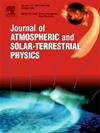Machine learning based method for dynamic forecasting of total electron content in the equatorial ionosphere
IF 1.9
4区 地球科学
Q3 GEOCHEMISTRY & GEOPHYSICS
Journal of Atmospheric and Solar-Terrestrial Physics
Pub Date : 2025-04-30
DOI:10.1016/j.jastp.2025.106533
引用次数: 0
Abstract
The total electron content in the ionosphere is a vital parameter for the users of the Global Navigation Satellite System (GNSS) as it causes a delay in the satellite signal propagating through it, which in turn degrades the positional accuracy of the receiver. Thus, improving the GNSS positioning requires precise ionospheric Total Electron Content (TEC) prediction, especially in the equatorial region where complex electrodynamics and erratic space weather events introduce substantial short-term variability. Although deep learning techniques have shown promise, they frequently rely heavily on large historical datasets, are computationally demanding, and are not interpretable. In this work, we propose a Multiclass Classifier Short-Term Dynamic Prediction Model (MSTDM) that uses reliable and interpretable machine learning techniques to forecast Vertical TEC (VTEC) 30 min ahead of time. The model optimizes the training set using a threshold-based learning algorithm to identify nonrepetitive and relevant VTEC patterns from recent data. The model uses polynomial interpolation to impute missing values, and a sliding window method is used to extract temporal features, which are then further refined through statistical feature selection. The continuous VTEC values are first discretized into distinct classes, after which Support Vector Machines (SVM) and Random Forests (RF) were employed for supervised classification. Different feature selection techniques were used. Prediction accuracy for SVM and RF with Recursive Feature Elimination (RFE) demonstrated the best results during geomagnetic storm days. The results varied from 85 to 91 % and 87–92 %, respectively. The RF-RFE model outperformed other configurations with 99 % training accuracy and 96 % test accuracy. Thus, this method provided a high-performing, interpretable, and computationally efficient solution for short-term VTEC forecasting.
基于机器学习的赤道电离层总电子含量动态预报方法
电离层中的总电子含量是全球导航卫星系统(GNSS)用户的一个重要参数,因为它会导致卫星信号通过电离层传播的延迟,从而降低接收机的定位精度。因此,提高GNSS定位需要精确的电离层总电子含量(TEC)预测,特别是在赤道地区,复杂的电动力学和不稳定的空间天气事件会带来大量的短期变化。尽管深度学习技术已经显示出前景,但它们通常严重依赖于大型历史数据集,计算要求高,并且不可解释。在这项工作中,我们提出了一个多类分类器短期动态预测模型(MSTDM),该模型使用可靠且可解释的机器学习技术提前30分钟预测垂直TEC (VTEC)。该模型使用基于阈值的学习算法优化训练集,从最近的数据中识别非重复和相关的VTEC模式。该模型采用多项式插值法对缺失值进行插值,采用滑动窗口法提取时间特征,并通过统计特征选择对时间特征进行细化。首先将连续的VTEC值离散成不同的类别,然后利用支持向量机(SVM)和随机森林(RF)进行监督分类。采用了不同的特征选择技术。基于递推特征消去的SVM和RF在地磁风暴期间的预测精度最好。结果分别为85 ~ 91%和87 ~ 92%。RF-RFE模型以99%的训练准确率和96%的测试准确率优于其他配置。因此,该方法为VTEC短期预报提供了一种高性能、可解释且计算效率高的解决方案。
本文章由计算机程序翻译,如有差异,请以英文原文为准。
求助全文
约1分钟内获得全文
求助全文
来源期刊

Journal of Atmospheric and Solar-Terrestrial Physics
地学-地球化学与地球物理
CiteScore
4.10
自引率
5.30%
发文量
95
审稿时长
6 months
期刊介绍:
The Journal of Atmospheric and Solar-Terrestrial Physics (JASTP) is an international journal concerned with the inter-disciplinary science of the Earth''s atmospheric and space environment, especially the highly varied and highly variable physical phenomena that occur in this natural laboratory and the processes that couple them.
The journal covers the physical processes operating in the troposphere, stratosphere, mesosphere, thermosphere, ionosphere, magnetosphere, the Sun, interplanetary medium, and heliosphere. Phenomena occurring in other "spheres", solar influences on climate, and supporting laboratory measurements are also considered. The journal deals especially with the coupling between the different regions.
Solar flares, coronal mass ejections, and other energetic events on the Sun create interesting and important perturbations in the near-Earth space environment. The physics of such "space weather" is central to the Journal of Atmospheric and Solar-Terrestrial Physics and the journal welcomes papers that lead in the direction of a predictive understanding of the coupled system. Regarding the upper atmosphere, the subjects of aeronomy, geomagnetism and geoelectricity, auroral phenomena, radio wave propagation, and plasma instabilities, are examples within the broad field of solar-terrestrial physics which emphasise the energy exchange between the solar wind, the magnetospheric and ionospheric plasmas, and the neutral gas. In the lower atmosphere, topics covered range from mesoscale to global scale dynamics, to atmospheric electricity, lightning and its effects, and to anthropogenic changes.
 求助内容:
求助内容: 应助结果提醒方式:
应助结果提醒方式:


